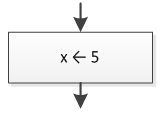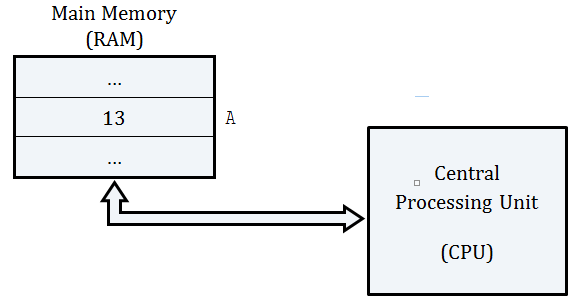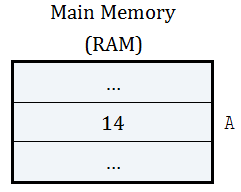The most commonly used operator in a computer language is the value assignment operator ( = ). For example, the statement
PHP
$x = 5;
Java, C++, C#
x = 5;
Visual Basic, Python
x = 5
assigns a value of 5 to variable x.
As you already know, this is equivalent to the left arrow used in flowcharts.

Probably the left arrow used in a flowchart is more convenient and clearer than the value assignment operator ( = ) sign because it shows in a more graphical way that the value or the result of an expression on the right is assigned to a variable on the left.
Be careful! The ( = ) sign is not equivalent to the one used in mathematics. In mathematics, the expression x = 5 is read as “x is equal to 5.” However, in a computer language the expression x = 5 is read as “assign the value 5 to x” or “set x equal to 5.” They look the same but they act differently!
In mathematics, the following two lines are equivalent:
x = y + z
y + z = x
The first one can be read as “x is equal to the sum of y and z” and the second one as “the sum of y and z is equal to x.”
On the other hand, in a computer language, the following two statements are definitely not equivalent. In fact, the second one is considered wrong!
PHP
$x = $y + $z;
$y + $z = $z;
Java, C++, C#
x = y + z;
y + z = x;
Visual Basic, Python
x = y + z
y + z = x
The first statement seems quite correct. It can be read as “Set x equal to the sum of y and z” or “Assign the sum of y and z to x.”
But what about the second one? Think! Is it possible to assign the value of x to y + z? The answer is obviously a big “NO!”
Remember! In a computer language, the variable on the left side of the ( = ) sign represents a region in main memory (RAM) where a value can be stored. Thus, on the left side only one single variable must exist! However, on the right side there can be a number, a variable, a string, or even a complex mathematical expression.
In Table 1 you can find some examples of value assignments.
PHP
| Table 1 Examples of Value Assignments | |
$a = 9; |
Assign a value of 9 to variable a. |
$b = $c; |
Assign the content of variable c to variable b. |
$d = "Hello Zeus"; |
Assign the string Hello Zeus to variable d. |
$d = $a + $b; |
Calculate the sum of the contents of variables a and b and assign the result to variable d. |
$b = $a + 1; |
Calculate the sum of the content of variable a and 1 and assign the result to variable b. Please note that the content of variable a is not altered. |
$a = $a + 1; |
Calculate the sum of the content of variable a and 1 and assign the result back to variable a. In other words, increase variable a by one. |
Java, C++, C#
| Table 1 Examples of Value Assignments | |
a = 9; |
Assign a value of 9 to variable a. |
b = c; |
Assign the content of variable c to variable b. |
d = "Hello Zeus"; |
Assign the string Hello Zeus to variable d. |
d = a + b; |
Calculate the sum of the contents of variables a and b and assign the result to variable d. |
b = a + 1; |
Calculate the sum of the content of variable a and 1 and assign the result to variable b. Please note that the content of variable a is not altered. |
a = a + 1; |
Calculate the sum of the content of variable a and 1 and assign the result back to variable a. In other words, increase variable a by one. |
Visual Basic, Python
| Table 1 Examples of Value Assignments | |
a = 9 |
Assign a value of 9 to variable a. |
b = c |
Assign the content of variable c to variable b. |
d = "Hello Zeus" |
Assign the string Hello Zeus to variable d. |
d = a + b |
Calculate the sum of the contents of variables a and b and assign the result to variable d. |
b = a + 1 |
Calculate the sum of the content of variable a and 1 and assign the result to variable b. Please note that the content of variable a is not altered. |
a = a + 1 |
Calculate the sum of the content of variable a and 1 and assign the result back to variable a. In other words, increase variable a by one. |
Confused about the last one? Are you thinking about your math teacher right now? What would he/she say if you had written a = a + 1 on the blackboard? Can you personally think of a number that is equal to the number itself plus one? Are you nuts? This means that 5 is equal to 6 and 10 is equal to 11!
Obviously, things are different in computer science. The statement a = a + 1 is absolutely acceptable! It instructs the CPU to retrieve the value of variable a from main memory (RAM), to increase the value by one, and to assign the result back to variable a. The old value of variable a is replaced by the new one.
Still don’t get it? Let’s take a look at how the CPU and main memory (RAM) cooperate with each other in order to execute the statement A ← A + 1.
Let’s say that there is a region in memory, named A and it contains the number 13

When a program instructs the CPU to execute the statement
A ← A + 1
the following procedure is executed:
- the number 13 is transferred from the RAM’s region named
Ato the CPU; - the CPU calculates the sum of 13 and 1; and
- the result, 14, is transferred from the CPU to the RAM’s region named
Areplacing the existing number, 13.
After execution, the RAM looks like this.
